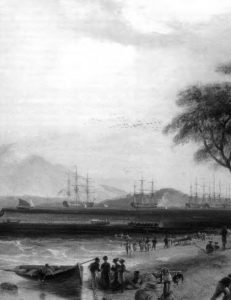 Indonesia, a vast archipelago containing many thousands of inhabited and uninhabited islands, is the fourth most populous country on the planet. The Indonesian Archipelago is 5,000 kilometers in breadth and straddles the equator, with a dramatic diversity of flora and fauna. Indonesia contains the fabled Spice Islands· the Moluccas that Iberian and other European explorers sought in the epic voyages of the fifteenth and sixteenth centuries. Long before the Europeans finally arrived in the early sixteenth century, Chinese, Arab and Indian traders had been active in the islands forming the Indonesian Archipelago. Initially, the islands attracted traders seeking to exchange goods for spices such as cloves, cinnamon, nutmeg and mace that were native species of the Moluccas. The annals of the Han Dynasty in China (206 B.C.E.–200 C.E.) mention the use of cloves, and a Roman law digest refers unambiguously to this spice as far back as 176 C.E. Arab references to trade in cloves appear as early as the tenth century C.E. (Muller, 1990).
Indonesia, a vast archipelago containing many thousands of inhabited and uninhabited islands, is the fourth most populous country on the planet. The Indonesian Archipelago is 5,000 kilometers in breadth and straddles the equator, with a dramatic diversity of flora and fauna. Indonesia contains the fabled Spice Islands· the Moluccas that Iberian and other European explorers sought in the epic voyages of the fifteenth and sixteenth centuries. Long before the Europeans finally arrived in the early sixteenth century, Chinese, Arab and Indian traders had been active in the islands forming the Indonesian Archipelago. Initially, the islands attracted traders seeking to exchange goods for spices such as cloves, cinnamon, nutmeg and mace that were native species of the Moluccas. The annals of the Han Dynasty in China (206 B.C.E.–200 C.E.) mention the use of cloves, and a Roman law digest refers unambiguously to this spice as far back as 176 C.E. Arab references to trade in cloves appear as early as the tenth century C.E. (Muller, 1990).
Independence
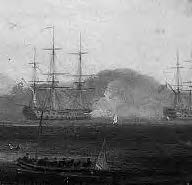 Eventually, the Netherlands came to dominate Indonesia and put in place a monopoly on international trade in cloves in the form of the East Indies Company. Under Dutch control for three centuries, a series of new export crops were developed or introduced including pepper, coffee, rubber, and sugar. Indonesia finally broke free of Dutch control after a struggle that began with a declaration of independence on August 17, 1945 and ended on August 17, 1950. The United States in 1949 supported a United Nations Security Council resolution ordering the Dutch to withdraw and negotiate. The battlefield successes of the youthful Indonesian army, coupled with international opinion, sealed the end of Dutch colonial rule. A new era of independence dawned on the vast archipelago.
Eventually, the Netherlands came to dominate Indonesia and put in place a monopoly on international trade in cloves in the form of the East Indies Company. Under Dutch control for three centuries, a series of new export crops were developed or introduced including pepper, coffee, rubber, and sugar. Indonesia finally broke free of Dutch control after a struggle that began with a declaration of independence on August 17, 1945 and ended on August 17, 1950. The United States in 1949 supported a United Nations Security Council resolution ordering the Dutch to withdraw and negotiate. The battlefield successes of the youthful Indonesian army, coupled with international opinion, sealed the end of Dutch colonial rule. A new era of independence dawned on the vast archipelago.
The “Guided Economy”
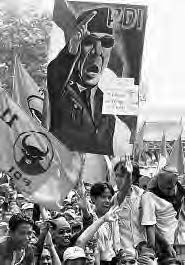
Megawati Sukarnoputri while holding a poster of her father, Sukarno, on the East Javanese island of Madura, May 29, 1999.
© AFP/CORBIS
During the 1950s, Indonesia was considered by Dutch social scientists to be a classic case of a “dual economy” (Boeke, 1953). In such a society, enclaves of capitalist large-scale plantation agriculture and mining existed alongside small-scale subsistence farming and petty crafts. The latter sectors encompassed the bulk of the populace and were alleged to operate under separate economic laws than those of the foreign-oriented capitalist sector. Therefore, it was asserted that Western economic theory was irrelevant to an understanding of the economy of less developed countries such as Indonesia. The influence of such thinking on the policies chosen by the Indonesian government was evident.1
Upon independence the economy remained dependent on the plantations and mines that were developed under the Dutch for earning foreign exchange. Manufacturing activity was very limited and small scale. Indonesia was unable to produce enough rice to meet the food requirements of a rapidly growing population. Poverty and illiteracy were widespread. Dutch expatriates still managed many of the country’s plantations and merchants, traders and moneylenders of Chinese descent dominated commercial activity in the country.
President Sukarno chafed under the lingering Dutch influence on the economy and sought to enhance the economic fortunes of the Pribumis (indigenous Indonesians). In 1959, political unrest throughout the country and rebellion in outlying provinces provided Sukarno with an excuse to declare martial law. The plantations were nationalized, and management was transferred to bureaucrats. In addition, industrial development was to be accomplished by the state, resulting in “the guided economy” of 1959–65. President Sukarno focused on prestige projects and paid little attention to day-to-day management of the country’s finances. He sought military confrontation with neighboring countries and identified himself with the large Indonesian Communist Party (PKI).
Increasingly chaotic political and social conditions contributed to economic stagnation, a collapse of exports, and capital flight. Traders were compelled to evade controls by smuggling goods in and out of the country. In no small part this fed the unrest in outlying regions such as Aceh and Northern Sulawesi, where economic activities were strongly oriented towards foreign trade. Eventually Sukarno’s policies proved to be disastrous as Indonesia became unable to afford imported necessities such as rice and other foodstuffs. Mismanagement of finances and disruption of trade resulted in massive inflation.
Indonesia was mired in poverty following years of economic mismanagement in the 1960s. Its economy was in tatters, suffering from low economic growth, hyperinflation, and stifling bureaucratic controls. The government defaulted on its foreign debt and was effectively cut off from foreign assistance. Foreign exchange controls and protectionist policies had disengaged domestic industry from international trade and investment. Corruption was rampant, and food shortages arose due to the strangulation of domestic and international trade. Indonesia was surely one of the poorest countries in the world.
The New Order
President Sukarno ruled the country until his overthrow in a 1965 military coup. His successor, President Suharto, remained in control for over three decades. During the late 1960s, Suharto had to work hard to consolidate power, and this meant mending the economy and restoring trade and investment ties with the rest of the world. In this period, President Suharto was receptive to the advice of a small group of University of California-Berkeley trained economists—the so-called Berkeley Mafia.2 Following the advice of Western-trained economists, foreign exchange controls were abolished, quantitative restrictions on trade were replaced by tariffs, monetary and fiscal policies were put in order with a balanced budget, and foreign capital was invited to return. The United States and other countries including Japan forgave Indonesia’s debt and restored foreign assistance programs.
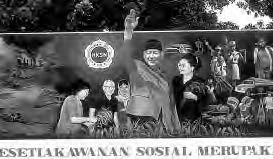
© CORBIS
Under the new policies, political stability was restored and economic growth accelerated. Outward-oriented policies were maintained under the influence of the Berkeley Mafia until petroleum reserves were discovered and developed. An oil-boom period occurred, providing Indonesia with an abundance of foreign exchange. Unlike some of the other oil-rich developing economies (e.g., Nigeria), Indonesia invested in agriculture, rural development, human resources and infrastructure improvements. The hand of the Berkeley Mafia was still apparent, as progress was made toward increased self-sufficiency in rice production and rising educational attainment and living standards.
However, between 1972 and 1985, the economists’ influence over trade policies waned somewhat, and Suharto increasingly adopted restrictive trade and investment policies. Foreign investment was controlled and guided by the government, and applications had to receive presidential approval. In this period, state enterprises in sectors such as steel, shipbuilding and aircraft were favored, and a group of “engineers” under the leadership of Science and Technology Minister B. J. Habibie increasingly had the President’s ear. The growing restrictions and large inflow of oil money led to a situation where decisions were aimed at benefiting a small group of people personally close to the President, including his family.
Suddenly, the country was forced to wean itself of oil dependence as prices collapsed to under $10 per barrel in 1985 and 1986. The President once again turned for advice to a now aging Berkeley Mafia. The economists urged him to begin to undertake a program of deregulation and trade liberalization. A large devaluation of the rupiah in 1986 and very significant reduction in quantitative restrictions and import tariffs kindled a boom in non-oil exports. Indonesia soon became a major exporter of manufactured goods such as textiles, clothing, footwear and wood products. Foreign investment was also liberalized to a large extent.
However, cartels were created in key export sectors such as plywood and placed under the control of Suharto cronies. Parallel to the deregulation, state funds and loans from state-controlled banks continued flowing to pet projects of Habibie and the engineers. The showcase project was the commercial aircraft produced by the state-owned aerospace company IPTN that was run by Habibie. The government political party, Golkar, also was able to distribute largesse in return for loyalty to the regime.
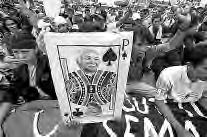
© CORBIS
In addition, it is apparent that Suharto family members were granted every conceivable advantage in building up their own business empires. This included monopoly control over some spices, including cloves, as well as other domestic industries such as citrus fruit. The Suharto children became increasingly prominent in being awarded government contracts for items such as toll roads and power projects and in the poorly conceived “national car” program. Other cronies were amply funded in developing huge projects such as the now bankrupt Chandra Asri petrochemical complex. Ominously, the number of bad loans in the banking system, particularly of the state banks, began rising. Supervision over financial institutions was extremely lax. Private corporations’ short-term external debt was also rapidly increasing as more and more hot money flowed into the economy.
Despite these adverse trends, there can be no doubt that international trade and investment figured prominently in the largely successful long-term development of Indonesia. Among the fast-growing Asian economies between 1965 and 1996, Indonesia had been singled out as “one of the most remarkable development success stories” (Hill, 1997). It had transformed itself from the chaos preceding the military takeover. Just three decades later Indonesia’s achievements included a significant reduction in the incidence of poverty among a population of nearly 200 million. Rapid economic growth, sustained over a period of three decades, had lifted many millions of Indonesians out of poverty. Underlying the growth performance were improvements in productivity (particularly in agriculture), health, and education. These improvements encouraged reduced population growth, rising private savings and investment, and an economy that was increasingly open to foreign trade and investment.
Viewed by most as an emerging Asian tiger economy, no one expected or predicted that suddenly Indonesia would experience an economic collapse in 1997 that would lead to the eventual downfall of President Suharto in 1998. Indonesia’s stellar economic performance during the Suharto years was, however, marred by the authoritarian political system and its accompaniments—corruption, cronyism, and injustice. The social tensions that had been suppressed for decades under Suharto’s iron grip came rapidly to the surface during and after his downfall.
Economic Crisis and Restoration of Democracy
Indonesia’s future prospects currently are clouded as it struggles towards a workable democracy that will accommodate the demands of an ethnically diverse population. Separatist unrest in outlying provinces such as Aceh and Irian Jaya, tensions between Christians and Moslems, and economic inequalities between Chinese and indigenous Indonesians are among the challenges facing the new government of President Wahid. These challenges have been ever present in modernday Indonesia, but have only recently come to the surface after many years of authoritarian government. The economic crisis that began in 1997 has exacerbated social tensions and undermined the credibility of the once dominant Golkar Party, opening the door to the opposition parties. Hence, the caretaker administration of President Habibie was short-lived. The newly elected President, Abdurrahaman Wahid, is a widely respected leader of the Moslem community and a strong advocate of democracy and human rights. He faces the arduous task of restoring a workable democracy and healing an ailing economy. His prospects for success depend critically on restoring economic growth and rising living standards for the Indonesian people.
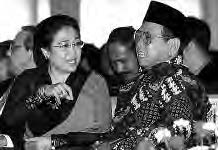
Indonesia has suffered the most severe economic crisis among the Asian countries, with the economy contracting by nearly 14 percent in 1998. Inflation reached 65 percent in 1998, and the Indonesian currency—the rupiah—has lost 70 percent of its value since the crisis began. The tragic events surrounding the last days of the Suharto government, including the shooting deaths of students and the anti-Chinese riots, led to an accelerated withdrawal of short-term capital from the country. The severity of the economic crisis in Indonesia has led to a claim by the World Bank (quoted in Hill, 1999) that “No country in recent history, let alone one the size of Indonesia, has ever suffered such a dramatic reversal of fortune.”
Despite the current conflict within Indonesia, it is surely a country that has bright future prospects. One of the most important elements in realizing a future of economic development and renewed social progress is the country’s access to international markets.
Signs of Recovery
Asia’s financial crisis appears to be over, and economic recovery has begun. The recovery has been strongest in Korea, which by some estimates grew by over 10 percent in 1999, but has also been strong in Thailand and Malaysia. Although Indonesia has lagged somewhat, there are now signs that recovery is afoot.3
The recovery has come more quickly and has been stronger than many observers expected. Fundamentally, the underpinnings of Asian economic growth were not destroyed by the crisis. Savings rates remain extremely high, a highly educated and skilled labor force developed in recent decades is still in place, and flexible, market-oriented policies are being strengthened. Among the reasons for the quick recovery is that these economies have been able to rapidly absorb large changes in relative prices with minimum social unrest. Real wages have adjusted downwards, preventing the overall quantity of jobs and employment from contracting much in the crisis. The dire predictions of large increases in open unemployment have not materialized. Many workers have accepted alternative jobs that are less remunerative than their former jobs, but they remain employed. Consumer spending is now rising in Indonesia, reflecting the improvement in overall economic conditions.
Moreover, as in other Asian countries shocked by the financial crisis, Indonesia’s economic competitiveness has been strengthened by the real exchange rate adjustment. Even accounting for the effects of inflation and nominal wage increases in response to inflation, it is apparent that there has been a substantial real depreciation of the rupiah. The devaluation has led to rising net exports in real terms, thus supporting economic recovery.
The recovery has come more quickly and has been stronger than many observers expected. Fundamentally, the underpinnings of Asian economic growth were not destroyed by the crisis. Savings rates remain extremely high, a highly educated and skilled labor force developed in recent decades is still in place, and flexible, market-oriented policies are being strengthened.
There remain several threats to the recovery process. Aside from political instability, the main threat to the recovery process is disarray in banking and the financial sector. The restructuring of banking and the corporate sector has a long way to go. The severity of the debt and bad loan problem in Indonesia can hardly be exaggerated. Cleaning up the banking mess and speeding up corporate restructuring is essential to the restoration of finance and a recovery of private investment.
The outlook for economic recovery also hinges on a favorable external environment. Japan and the United States are the two most important markets for Indonesian exports and are leading sources of foreign investment as well. Deterioration in the U.S. economy and continued weakness in Japan could have serious implications for Indonesian growth based on exports. Furthermore, a recession could tip trade policies in a protectionist direction and aggravate the problem for Indonesia. The failure to move forward with a global trade round after the World Trade Organization’s debacle in Seattle is indicative of the presence of rising trade frictions.
Conclusion
As teachers, what should we have learned from Indonesia’s experience with economic policy? What lessons can be derived that could be applied to other developing countries? First, experience teaches that economic incentives are very important in influencing behavior. Contrary to the “dualism” argument, Indonesians did respond when economic policies were improved after the chaotic collapse of the “guided economy” in the 1960s and again with deregulation in the mid-1980s. Second, interventions by government in promoting prestige projects and special interest groups are very costly. The high incidence of corruption and financial excesses associated with such policies are now evident. Third, the government has a very important role to play in provision of basic public goods and services. Investment in public health, education and training are key to long-run economic development. Fourth, economic crises are clearly associated with excessive borrowing and lax financial and fiscal practices. It is of utmost importance to improve supervision of banks, strengthen institutions concerned with oversight of corporate practices, and to improve performance of fiscal and monetary authorities. Reducing external debt and restoring the financial system are vital to a sustained economic recovery. Fifth, in order to stimulate growth it is important to maintain open trade and investment policies. These policies are particularly important for preservation of unity in outlying regions and for overall confidence in the governance of the country.
The close association between trade and investment and between these key variables and economic growth has been the focus of recent empirical studies. Frankel and Romer (1999, 394) conclude: “Trade appears to raise income by spurring the accumulation of physical and human capital and by increasing output for given levels of capital.” Indonesia has overcome severe obstacles to economic advance in the past and can do so again. The role open economic policies can play in enhancing the recovery should not be underestimated.
NOTES
1. Prominent Australian economist Benjamin Higgins was among the first to voice dissent with the dualistic theory of Boeke. See Higgins (1956) and Meier (1988: 129–30) for discussion.
2. See Subroto (1998) for a discussion of the role of the economists in the 1960s. 3. An excellent source of information on the Indonesian economy is the Bulletin of Indonesian Economic Studies, published by the Indonesia Project of the Australian National University (ANU) in Canberra. Another good source is the annual Indonesia Outlook published by the Institute of Southeast Asian Studies in Singapore (jointly with ANU).
REFERENCES
Asian Development Bank (ADB). Asia Recovery Report 2000 (March 2000). http://aric.adb.org.
Badan Pusat Statistik (BPS, Central Statistical Agency). Indikator Ekonomi (Economic Indicators). March 1999.
Bank Indonesia. Indonesian Financial Statistics (June 1999).
Bank of Korea. Monthly Balance of Payments (June 1999).
Bank of Thailand. Monthly Bulletin (May 1999).
Boeke, J. H. Economics and Economic Policy in Dual Societies. New York: Institute of Pacific Relations, 1953.
Frankel, Jeffrey and David Romer. “Does Trade Cause Growth?” in American Economic Review (June 1999).
Higgins, Benjamin. “The ‘Dualistic Theory’ of Underdevelopment,” in Economic Development and Cultural Change (January 1956).
Hill, Hal. The Indonesian Economy in Crisis. Singapore: Institute of Southeast Asian Studies— ISEAS, 1999. ———. Indonesia’s Industrial Transformation. Singapore: ISEAS, 1997. James, William. “The Impact of the Balance of Payments and Financial Crisis on Indonesia’s Foreign Trade and Economic Performance.” International Centre for the Study of East Asian Development— ICSEAD Working Paper Series, Vol. 99, August 16, 1999.
———. “Indonesia’s Non-Oil/Gas Export Performance in 1997 and Prospects for 1998.” ICSEAD Working Paper Series, Vol. 98, May 12, 1998.
———. “A Problem with Indonesia’s Export Statistics,” in Bulletin of Indonesian Economic Studies, Vol. 34, December 1998, pp.115–18.
———. “Indonesia: Non-Oil/Gas Export Performance in 1996 and Prospects for 1997.” ICSEAD Working Paper Series, Vol. 97, December 5, 1997, also published in East Asian Economic Perspectives, March 1998.
Kamininsky, Graciela, and Carmen Reinhart. “The Twin Crises: The Causes of Banking and Balanceof-Payments Problems” in American Economic Review, Vol. 89, No. 3, June 1999, pp. 473–500.
Meier, Gerald M. (ed.). Leading Issues in Economic Development, Fifth Edition. New York: Oxford University Press, 1988.
Muller, Kal. Spice Islands: The Moluccas. Berkeley: Periplus Editions, 1990. Pardede, Raden. “Survey of Recent Developments,” Bulletin of Indonesian Economic Studies, August 1999.
Subroto, Roberto. “Recollections of My Career,” Bulletin of Indonesian Economic Studies, August 1998.
Toida, Mitsuru. “Overview” in Toida, Mitsuru and Daisuke Harata (eds.) 1999 Economic Forecasts for Asian Industrializing Region. Institute of Developing Economies, Tokyo, May 1999. World Bank. Indonesia in Crisis: A Macroeconomic Update, Washington, D.C., 1998.

